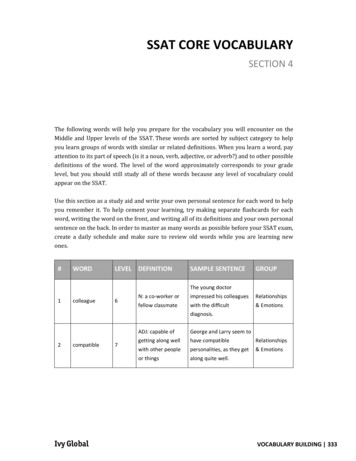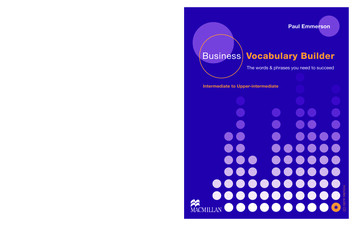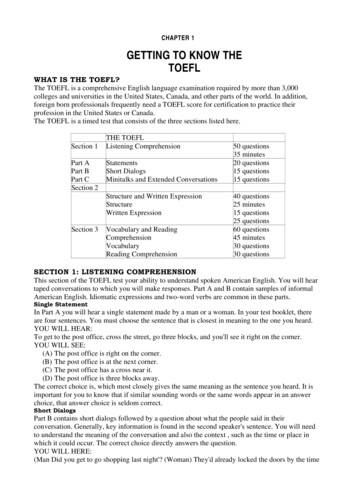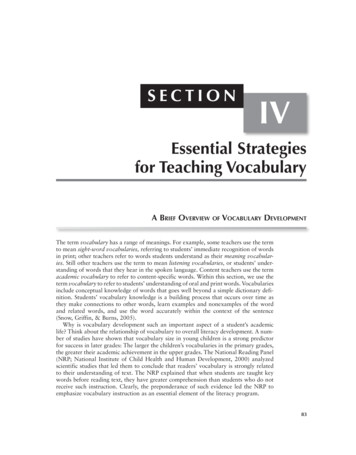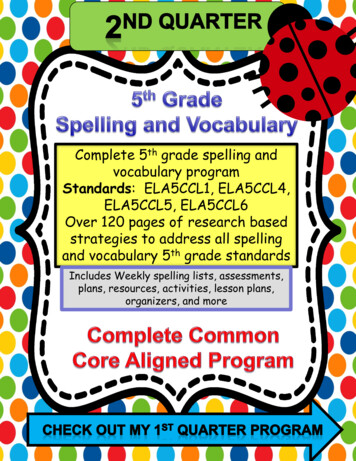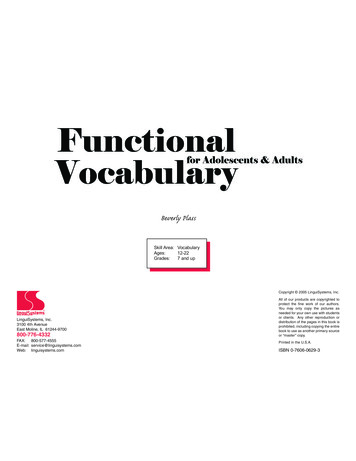
Transcription
Beverly PlassSkill Area: VocabularyAges:12-22Grades:7 and upCopyright 2005 LinguiSystems, Inc.LinguiSystems, Inc.3100 4th AvenueEast Moline, IL 61244-9700800-776-4332FAX: 800-577-4555E-mail: service@linguisystems.comWeb: linguisystems.comAll of our products are copyrighted toprotect the fine work of our authors.You may only copy the pictures asneeded for your own use with studentsor clients. Any other reproduction ordistribution of the pages in this book isprohibited, including copying the entirebook to use as another primary sourceor “master” copy.Printed in the U.S.A.ISBN 0-7606-0629-3
About the AuthorBeverly Plass, M.A., CCC-SLP, is a speech-language pathologist in the Irvine Unified SchoolDistrict in Irvine, California, and in private practice. She has worked with adolescents withdevelopmental disabilities for the past 14 years. She has found that the key to student successis tied to their ability to understand and communicate about living, working, and playing.Functional Vocabulary for Adolescents and Adults is Bev’s fourth publication with LinguiSystems.She is also the author of SPARC-R & S, SPARC-Artic Junior, and SPARC-L.DedicationThanks to my students for sharing their love for lifeAcknowledgmentsI’d like to thank three outstanding teachers: Carol Constantin, Carlon Fagan, and Liz Krogsdalefor modeling creative and productive ways to teach functional curriculum to young adults withdevelopmental disabilities. I am fortunate to have collaborated with them over the past 14 years.I am grateful to them for what I have learned and how it significantly influenced the developmentof this book.Functional Vocabulary for Adolescents & AdultsCopyright 2005 LinguiSystems, Inc.
Table of ContentsIntroduction.6Vocabulary at HomeBathroom . . . . . . . . . . . . . . . . . . . . . . . . . . . . . . . . . . . . . . . . . 8Bedroom . . . . . . . . . . . . . . . . . . . . . . . . . . . . . . . . . . . . . . . . . 10Clothing . . . . . . . . . . . . . . . . . . . . . . . . . . . . . . . . . . . . . . . . . 12Clothing for Men . . . . . . . . . . . . . . . . . . . . . . . . . . . . . . . . . . . 14Clothing for Winter . . . . . . . . . . . . . . . . . . . . . . . . . . . . . . . . . 16Clothing for Women . . . . . . . . . . . . . . . . . . . . . . . . . . . . . . . . 18Grooming – Hair Care . . . . . . . . . . . . . . . . . . . . . . . . . . . . . . 20Grooming – Teeth & Fingernails . . . . . . . . . . . . . . . . . . . . . . 22Grooming – Washing & Shaving . . . . . . . . . . . . . . . . . . . . . . 24Kitchen – Appliances . . . . . . . . . . . . . . . . . . . . . . . . . . . . . . . 26Kitchen – Cooking . . . . . . . . . . . . . . . . . . . . . . . . . . . . . . . . . 28Kitchen – Cookware/Bakeware . . . . . . . . . . . . . . . . . . . . . . . 30Kitchen – Cutting Utensils . . . . . . . . . . . . . . . . . . . . . . . . . . . 32Kitchen – Tableware . . . . . . . . . . . . . . . . . . . . . . . . . . . . . . . . 34Kitchen – Utensils 1 . . . . . . . . . . . . . . . . . . . . . . . . . . . . . . . . 36Kitchen – Utensils 2 . . . . . . . . . . . . . . . . . . . . . . . . . . . . . . . . 38Kitchen – Washing Dishes . . . . . . . . . . . . . . . . . . . . . . . . . . . 40Laundry – Nouns . . . . . . . . . . . . . . . . . . . . . . . . . . . . . . . . . . 42Laundry – Verbs . . . . . . . . . . . . . . . . . . . . . . . . . . . . . . . . . . . 44Nutrition – Breads & Grains . . . . . . . . . . . . . . . . . . . . . . . . . . 46Nutrition – Fruits . . . . . . . . . . . . . . . . . . . . . . . . . . . . . . . . . . . 48Nutrition – Meat & Protein . . . . . . . . . . . . . . . . . . . . . . . . . . . 50Nutrition – Milk, Yogurt, & Cheese . . . . . . . . . . . . . . . . . . . . . 52Nutrition – Vegetables . . . . . . . . . . . . . . . . . . . . . . . . . . . . . . 54What’s for Breakfast? . . . . . . . . . . . . . . . . . . . . . . . . . . . . . . . 56What’s for Dinner? . . . . . . . . . . . . . . . . . . . . . . . . . . . . . . . . . 58What’s for Lunch? . . . . . . . . . . . . . . . . . . . . . . . . . . . . . . . . . 60Functional Vocabulary for Adolescents & AdultsVocabulary in the CommunityApartment . . . . . . . . . . . . . . . . . . . . . . . . . . . . . . . . . . . . . . . . 62ATM (Automated Teller Machine) . . . . . . . . . . . . . . . . . . . . . .64Bank . . . . . . . . . . . . . . . . . . . . . . . . . . . . . . . . . . . . . . . . . . . . 66City Bus . . . . . . . . . . . . . . . . . . . . . . . . . . . . . . . . . . . . . . . . . 68Clothing Store . . . . . . . . . . . . . . . . . . . . . . . . . . . . . . . . . . . . . 70Dentist’s Office . . . . . . . . . . . . . . . . . . . . . . . . . . . . . . . . . . . . 72Discount Department Store . . . . . . . . . . . . . . . . . . . . . . . . . . 74Doctor’s Office . . . . . . . . . . . . . . . . . . . . . . . . . . . . . . . . . . . . 76Fast-Food Restaurant . . . . . . . . . . . . . . . . . . . . . . . . . . . . . . 78Grocery Shopping . . . . . . . . . . . . . . . . . . . . . . . . . . . . . . . . . 80Grocery Store . . . . . . . . . . . . . . . . . . . . . . . . . . . . . . . . . . . . . 82Hardware Store . . . . . . . . . . . . . . . . . . . . . . . . . . . . . . . . . . . 84Library/Bookstore . . . . . . . . . . . . . . . . . . . . . . . . . . . . . . . . . . 86Pet Store . . . . . . . . . . . . . . . . . . . . . . . . . . . . . . . . . . . . . . . . 88Restaurant . . . . . . . . . . . . . . . . . . . . . . . . . . . . . . . . . . . . . . . 90School Supplies . . . . . . . . . . . . . . . . . . . . . . . . . . . . . . . . . . . 92Signs . . . . . . . . . . . . . . . . . . . . . . . . . . . . . . . . . . . . . . . . . . . 94Sporting Goods Store . . . . . . . . . . . . . . . . . . . . . . . . . . . . . . . 96Stationery Store . . . . . . . . . . . . . . . . . . . . . . . . . . . . . . . . . . . 98Toy Store . . . . . . . . . . . . . . . . . . . . . . . . . . . . . . . . . . . . . . . 100Vocabulary at WorkJob Choices . . . . . . . . . . . . . . . . . . . . . . . . . . . . . . . . . . . . . 102Getting a Job . . . . . . . . . . . . . . . . . . . . . . . . . . . . . . . . . . . . 104What to Wear to Work . . . . . . . . . . . . . . . . . . . . . . . . . . . . . 106People You Work With . . . . . . . . . . . . . . . . . . . . . . . . . . . . . 108Attributes . . . . . . . . . . . . . . . . . . . . . . . . . . . . . . . . . . . . . . . 110Baker Helper . . . . . . . . . . . . . . . . . . . . . . . . . . . . . . . . . . . . . 112Dining Room Attendant – Fast-Food Restaurant . . . . . . . . . 114Copyright 2005 LinguiSystems, Inc.
Table of Contents, continuedDining Room Attendant – Restaurant . . . . . . . . . . . . . . . . . . 116Floor Cleaning Supplies . . . . . . . . . . . . . . . . . . . . . . . . . . . . 118Housecleaning Supplies . . . . . . . . . . . . . . . . . . . . . . . . . . . . 120Laundry Worker . . . . . . . . . . . . . . . . . . . . . . . . . . . . . . . . . . 122Lawn and Garden Tools . . . . . . . . . . . . . . . . . . . . . . . . . . . . 124Office Helper Tasks . . . . . . . . . . . . . . . . . . . . . . . . . . . . . . . 126Office Helper Advanced Tasks . . . . . . . . . . . . . . . . . . . . . . . 128Stock Clerk . . . . . . . . . . . . . . . . . . . . . . . . . . . . . . . . . . . . . . 130Stock Clerk – Clothing Store . . . . . . . . . . . . . . . . . . . . . . . . 132Stock Clerk Tasks . . . . . . . . . . . . . . . . . . . . . . . . . . . . . . . . . 134Vehicle Cleaning Supplies . . . . . . . . . . . . . . . . . . . . . . . . . . 136Vocabulary During Leisure ActivitiesAmusement Park . . . . . . . . . . . . . . . . . . . . . . . . . . . . . . . . . 138Arcade . . . . . . . . . . . . . . . . . . . . . . . . . . . . . . . . . . . . . . . . . 140Art . . . . . . . . . . . . . . . . . . . . . . . . . . . . . . . . . . . . . . . . . . . . .142Baseball . . . . . . . . . . . . . . . . . . . . . . . . . . . . . . . . . . . . . . . . 144Functional Vocabulary for Adolescents & AdultsBasketball . . . . . . . . . . . . . . . . . . . . . . . . . . . . . . . . . . . . . . . 146Birthday Party . . . . . . . . . . . . . . . . . . . . . . . . . . . . . . . . . . . . 148Board Games . . . . . . . . . . . . . . . . . . . . . . . . . . . . . . . . . . . . 150Bowling . . . . . . . . . . . . . . . . . . . . . . . . . . . . . . . . . . . . . . . . . 152Camping . . . . . . . . . . . . . . . . . . . . . . . . . . . . . . . . . . . . . . . . 154Carnival . . . . . . . . . . . . . . . . . . . . . . . . . . . . . . . . . . . . . . . . 156Crafts . . . . . . . . . . . . . . . . . . . . . . . . . . . . . . . . . . . . . . . . . . 158Dance . . . . . . . . . . . . . . . . . . . . . . . . . . . . . . . . . . . . . . . . . . 160Electronic Entertainment . . . . . . . . . . . . . . . . . . . . . . . . . . . 162Football . . . . . . . . . . . . . . . . . . . . . . . . . . . . . . . . . . . . . . . . . 164Fun Choices . . . . . . . . . . . . . . . . . . . . . . . . . . . . . . . . . . . . . 166Gym . . . . . . . . . . . . . . . . . . . . . . . . . . . . . . . . . . . . . . . . . . . 168Horseback Riding . . . . . . . . . . . . . . . . . . . . . . . . . . . . . . . . . 170Miniature Golf . . . . . . . . . . . . . . . . . . . . . . . . . . . . . . . . . . . . 172Movie Theater . . . . . . . . . . . . . . . . . . . . . . . . . . . . . . . . . . . 174Poker . . . . . . . . . . . . . . . . . . . . . . . . . . . . . . . . . . . . . . . . . . 176Soccer . . . . . . . . . . . . . . . . . . . . . . . . . . . . . . . . . . . . . . . . . 178Copyright 2005 LinguiSystems, Inc.
IntroductionI once had two students who did job training at a nursery. Theyfilled pots with soil and planted cuttings into each pot. Thirtysix pots were arranged in a flat. One student worked steadilyand completed 10-12 flats in a two hour period. He was a quietguy. He would respond with one- to two-word utterances ifprodded, but he preferred to stick to his work. The young lady,however, was overly friendly. Each day, she greeted the coworkers with a loud, “I’m so glad to see you! What have youbeen up to?” She often stopped working to chat with the otherworkers. At the end of the two-hour period, she typicallycompleted one to two flats.as a Second Language. The flexible format allows you to caterthe lessons to a wide range of ability levels.Receptive tasks are appropriate for your clients who are nonverbal or new to learning English. These activities allow theclient to hear the target vocabulary words several times, respondby pointing, and apply the knowledge to real situations. Thereceptive tasks also include a “visual memory” component,which helps clients learn to communicate about things notpresent.Expressive tasks begin with simple picture-naming, sentenceimitation, and sentence completion. This allows clients withautism and clients beginning to use short utterances to usethe vocabulary in simple sentences. The expressive tasksthen expand to identifying categories, explaining functions,sequencing events, and recalling information. The recallingtasks are to help clients visualize and discuss things not present.Expressive activities allow clients to use the vocabulary duringmeaningful and functional activities. At the highest level, criticalthinking and problem solving questions allow the client to usethe new vocabulary while thinking of solutions to real-lifepredicaments.At the end of the year, the nursery owners offered paid employment to one of the workers, which was the ultimate goal of ourjob training program. We assumed the job would go to thehardworking, productive young man. Instead, the ownerschose the young lady because they felt that they could talkto her.I later read studies supporting the idea that employees whocan communicate effectively at work are more successful atkeeping their jobs. That is why I feel it is imperative to teachfunctional vocabulary to teens and young adults with developmental disabilities.You do not need to follow the units in this book sequentially.You can collaborate and choose lessons that correspond withclassroom units. For example, if the class is going to thegrocery store, you can use the units about nutrition, mealtimes,grocery shopping, and the grocery store. If your clients arevisiting job sites, you can use the units that correspond to theoccupations they’ll be observing and the places in theFunctional Vocabulary for Adolescents & Adults helps speechlanguage pathologists and special education teachers teachclients to understand and communicate about daily living. Youcan teach vocabulary related to the home, the community,work, and leisure activities. The lessons are geared towardclients with developmental disabilities, autism, and/or EnglishFunctional Vocabulary for Adolescents & Adults6Copyright 2005 LinguiSystems, Inc.
Introduction, continuedcommunity they’ll be visiting. Note: In the Vocabulary at Worksection, I used the Dictionary of Occupational Titles (UnitedStates Department of Labor – Fourth Edition, Revised 1991,which is available online at www.oalj.dol.gov/libdot.htm) as areference when determining how to label the job titles that arefeatured in this book. Feel free to modify the terminology sothat it fits your program or the job titles available in your area. Copy the pictures onto card stock. Cut them out andlaminate them to use for picture communication books. Have clients create personal dictionaries by adding apicture page to their folders each time they learn newwords. Use the community pictures to have clients help planthe next Community-Based Instruction.For any unit, you do not need to ask all of the questions ineach section. One client may focus on understanding thevocabulary while another client practices using the vocabularyin various sentences and answers questions. A third client cantarget problem solving tasks using the same topic. You canalso modify the expectations for any task. For example, in theExpressive Vocabulary section of a unit, you may ask oneclient to recall all six pictures and another client to recall onlythree pictures. The flexibility allows you the freedom to meetthe individual language needs of your clients across all of thetopic areas. Use the vocational pictures as a job interest survey. Use the pictures during a scavenger hunt while onCommunity-Based Instruction. Have clients practice expanding utterances, usingclear articulation, using appropriate voice levels,and speaking fluently.Functional Vocabulary for Adolescents & Adults helps youteach your clients the terms they need to be successful ineveryday life.You may also use the pictures in this book for other activities: Create written language assignments that correspondwith the vocabulary. Clients can write definitions andanswer the expressive questions in writing.Functional Vocabulary for Adolescents & AdultsBeverly Plass7Copyright 2005 LinguiSystems, Inc.
Vocabulary at Home: BathroomFunctional Vocabulary for Adolescents & Adults8Copyright 2005 LinguiSystems, Inc.
BathroomReceptive VocabularyName each picture the client points to.1. Point to the shower (medicine cabinet, toilet, sink, bathtub,vanity).2. Show me where you can take a bath.3. Where can you stand and clean your body?4. Which flushes?5. Where do you keep a toothbrush? shampoo?6. Where do you keep medicine? a brush?7. Where do you brush your teeth?8. Where do you wash your hands?9. Which do you like to take, a bath or a shower?10. Which do you have in your bathroom?Receptive ActivitiesBefore doing these activities, make two copies of the picturegrid. Cut apart one grid to make picture cards.1. Give the student the picture grid. Have her match thepicture cards to the pictures on the grid. Where is the?2. Place the picture cards faceup on the table. Photocopyand cut out the picture cards from the Grooming: Hair Careand Teeth & Fingernails units. Have the student tell whereshe keeps each item. Show me where you keep .3. Place the picture cards faceup on the table. Have thestudent follow your directions. Touch the .Take the . Hand me the . Point to the .Turn over the .4. Cover three to six of the pictures on the picture grid.Show the student a picture card and have her tell youwhere it was on the picture grid. Where was the ?5. Use ads from a hardware store or look on a homeremodeling website. Find a .6. Visit a hardware store, an apartment, or a student’s home.Have the student find items that match the pictures.Let’s look for a .Vocabulary at HomeFunctional Vocabulary for Adolescents & AdultsWord/Sentence Imitation and Sentence Completion1. Ask the client to repeat each word after you say it. Say .2. Use each word to complete the sentence This is a . Have the clientrepeat your sentences.3. Print A is in the bathroom on a card. Have the client complete thesentence using the vocabulary words.Expressive Vocabulary1. Name each picture.2. What do all of these have in common?3. After shopping, where would you put shampoo (toothpaste, bar of soap,toilet paper, aspirin)?4. While putting away clean laundry, where would you put towels (washcloths,the bath mat)?5. What do you do in the bathtub? shower?6. What do you do at the sink?7. Name three things you keep in your medicine cabinet.8. Tell three things you keep in your vanity.9. What does your bathroom look like?10. (Cover the pictures.) Name six items in your bathroom.Expressive ActivityFind websites that include bathroom accessories, such as bath mats, shower curtains,washcloths, and soap dishes, or look in bathroom supply store ads. Talk with the clientabout where she could put each item in her bathroom.Critical Thinking and Problem Solving1.2.3.4.5.6.7.8.9.10.What would you do if the bath water was too hot?What would you do if the bathroom floor got wet?What could you do if the sink was clogged?What do you do to keep your body clean?Where should you keep medicine so that small children can’t reach it?If the bathroom door is closed, how can you find out if someone is inside?Why do we close the bathroom door when using the toilet?Why is it a good idea to shower or bathe daily?How do you know if you need to shower or bathe?How does keeping your body clean make a good impression?9Copyright 2005 LinguiSystems, Inc.
Vocabulary at Home: BedroomFunctional Vocabulary for Adolescents & Adults10Copyright 2005 LinguiSystems, Inc.
BedroomReceptive VocabularyName each picture the client points to.1. Point to the pillow (bed, nightstand, blanket, dresser,closet).2. Show me where you sleep.3. Which do you put your head on?4. Which keeps you warm at night?5. Where do you keep your pants? shirts?6. Where do you keep your shoes? socks?7. Which have drawers?8. Which has doors?9. Which are soft?10. Show me what you have in your room.Receptive ActivitiesBefore doing these activities, make two copies of the picturegrid. Cut apart one grid to make picture cards.1. Give the client the picture grid. Have him match the picturecards to the pictures on the grid. Where is the ?2. Play a game of Bingo. Use pennies as markers.3. Cut out pictures of items in a bedroom from magazinesor catalogs. Glue them to a sheet of paper, creating afew bedrooms. Show me the .4. Place the picture cards faceup on the table. Have theclient follow your directions. Touch the .Take the . Hand me the . Point to the .Turn over the .5. Cover three to six pictures on the picture grid. Show theclient a picture card and have him tell you where it was onthe picture grid. Where was the ?6. Use ads from a department store or bedroom furniturestore, or a website that contains bedroom furniture.Find a .7. Visit a furniture store, a department store, or an apartment.Find items that match the pictures. Let’s look for a .Vocabulary at HomeFunctional Vocabulary for Adolescents & AdultsWord/Sentence Imitation and Sentence Completion1. Ask the client to repeat each word after you say it. Say .2. Use each word to complete the sentence Here is a . Have the clientrepeat your sentences.3. Print A is in the bedroom on a card. Have the client complete thesentence using the vocabulary words.Expressive Vocabulary1.2.3.4.5.6.7.8.9.10.Name each picture.What do all of these items have in common?What does your bed look like?What does the furniture in your bedroom look like?When putting away clean clothes, where would you put (pajamas,shirts, pants, socks, shoes, jacket, shorts)?Name three things you keep in your closet.Tell three things you keep in your dresser.How are a dresser and a closet different?What do you do to keep your room clean?(Cover the pictures.) Name six items in your bedroom.Expressive ActivityUse newspaper ads or websites that contain bedroom furniture and furnishings.Let the client cut out pictures and arrange them on paper to design a bedroom.Have the client discuss why he chose particular items and where he would putthem in the room and why.Critical Thinking and Problem Solving1.2.3.4.5.6.7.8.9.10.What could you do if you were cold at night while sleeping?What would you do if you overslept?What would you do if there were no socks in your drawer?When changing clothes, what do you do with your dirty clothes?What do you do to keep your room clean?What could you do if your closet and dresser are full and you got somenew clothes?What could you do to give you more time to get ready in the morning?What could you do if you aren’t getting enough sleep at night?How do you wake up in the morning?How could you plan what you are going to wear each day?11Copyright 2005 LinguiSystems, Inc.
Vocabulary at Home: ClothingFunctional Vocabulary for Adolescents & Adults12Copyright 2005 LinguiSystems, Inc.
ClothingReceptive VocabularyName each picture the client points to.1.2.3.4.5.6.7.8.9.10.Point to the shorts (pajamas, pants, belt, socks, and shirt).Show me what goes on your feet.Which goes on your legs?Which holds up your pants?Which do you wear when you sleep?Which could you wear to school?Which could you wear to work?Which would you wear if it was hot?Which of these do you have at home?Look at what you are wearing today. Point to your .Receptive ActivitiesBefore doing these activities, make two copies of the picturegrid. Cut apart one grid to make picture cards.1. Give the client the picture grid. Have her match the picturecards to the pictures on the grid. Where is /are the ?2. Cut out pictures of clothing from magazines or catalogs.Glue them to a sheet of paper, creating a few outfits.Show me the .3. Bring in a laundry basket full of clean clothes. Havethe client practice sorting and folding the clothes.Put the in this pile. Fold the .4. Place the picture cards faceup on the table. Have theclient follow your directions. Touch the .Take the . Hand me the . Point to the .Turn over the .5. Cover three to six pictures on the picture grid. Showthe client a picture card and have her tell you whereit was on the picture grid. Where was /were the ?6. Use ads, catalogs, or websites that contain clothing.Find (a) .7. Visit a clothing store or a department store. Use thepictures as a shopping list. Let’s look for (a) .Vocabulary at HomeFunctional Vocabulary for Adolescents & AdultsWord/Sentence Imitation and Sentence Completion1. Ask the client to repeat each word after you say it. Say .2. Use each word to complete the sentence I wear (a) . Have the clientrepeat your sentences.3. Print I have (a) on a card. Have the client complete the sentence usingthe vocabulary words.Expressive Vocabulary1.2.3.4.5.6.7.8.9.10.Name each picture.What do all of these items have in common?Describe what you are wearing.Where do you keep your clothes?Where can you buy clothing?What kinds of shirts are there?What kinds of pants are there?When would you wear shorts?Why do people wear belts?(Cover the pictures.) Name six clothing items.Expressive ActivityHave two clients pretend to put on a fashion show. One client can model the clothesshe is wearing while the other describes the outfit. Encourage the MC to “ham it up”and make the outfit sound glamorous.Critical Thinking and Problem Solving1.2.3.4.5.6.7.8.9.10.What can you do about wrinkled clothes?What do you do if a button falls off?What clothes are appropriate to wear to school?What would you wear to a job interview?What clothes would you pack for a weekend vacation?How do the clothes you wear help make an impression?How does the weather affect what you plan to wear?While buying clothes, how can you tell if the clothes fit?How can you tell if your clothes are dirty?How can you clean clothes that are dirty?13Copyright 2005 LinguiSystems, Inc.
Vocabulary at Home: Clothing for MenFunctional Vocabulary for Adolescents & Adults14Copyright 2005 LinguiSystems, Inc.
Clothing for MenReceptive VocabularyName each picture the client points to.1. Point to the dress shirt (T-shirt, polo shirt, underwear,tie, suit).2. Show me which you could wear to school.3. Which could you wear to a wedding?4. Which do you have at home?5. Which are you wearing today?6. Which go on a hanger?7. Which can you fold and put in a drawer?8. Which would you wear with the suit?9. Which could you wear with shorts?10. Which is personal?Receptive ActivitiesBefore doing these activities, make two copies of the picturegrid. Cut apart one grid to make picture cards.1. Give the client the picture grid. Have him match the picturecards to the pictures on the grid. Where is /are the ?2. Cut out pictures of men’s clothing from magazines orcatalogs. Glue them to a sheet of paper, creating a fewoutfits. Show me the .3. Bring in men’s T-shirts, polo shirts, and hangers. Pretendyou work at a clothing store. Fold the T-shirts. Hang thepolo shirts.4. Place the picture cards faceup on the table. Have theclient follow your directions. Touch the .Take the . Hand me the . Point to the .Turn over the .5. Cover three to six pictures on the picture grid. Show theclient a picture card and have him tell you where it was onthe picture grid. Where was/were the ?6. Use ads, catalogs, or websites that contain men’s clothing.Find (a) .7. Visit a clothing store or a department store. Use thepictures as a shopping list. Let’s look for (a) .Vocabulary at HomeFunctional Vocabulary for Adolescents & AdultsWord/Sentence Imitation and Sentence Completion1. Ask the client to repeat each word after you say it. Say .2. Use each word to complete the sentence I can wear (a) . Have the clientrepeat your sentences.3. Print I want to buy (a) on a card. Have the client complete the sentenceusing the vocabulary words.Expressive Vocabulary1.2.3.4.5.6.7.8.9.10.Name each picture.What do all of these items have in common?Which do you have?Describe what you are wearing.What would you wear to a formal dance?What would you wear to a job interview?What would you wear to exercise?Where could you buy T-shirts?Describe different kinds of shirts.(Cover the pictures.) Name six men’s clothing items.Expressive ActivityHave the client pretend to shop for new clothes. He can look at clothing adsor catalogs, or on the Internet. Ask the client to talk about the clothes he likesand dislikes.Critical Thinking and Problem Solving1.2.3.4.5.6.7.8.9.10.What could you do if you didn’t know how to tie a tie?What could you do if you got a spot on your shirt?What if a button is loose on your clothing?What if your pants are wrinkled?When changing in a dressing room, why should you close the door?Why shouldn’t others see you in your underwear?Tell how your clothing helps make an impression on others.When shopping, how can you tell if a dress shirt fits you?How do you know what size T-shirt or underwear to buy?How should you act when wearing a suit?15Copyright 2005 LinguiSystems, Inc.
Vocabulary at Home: Clothing for WinterFunctional Vocabulary for Adolescents & Adults16Copyright 2005 LinguiSystems, Inc.
Clothing for WinterReceptive VocabularyName each picture the client points to.1. Point to the sweater (scarf, coat, gloves, stocking cap,boots).2. Show me which keeps your hands warm.3. Which keeps your feet dry and warm?4. Which keeps your head warm?5. Which keeps your neck warm?6. Which keep your chest and arms warm?7. Which would you wear in the snow?8. Which would you wear in the rain?9. Which would you keep in the closet?10. Which are soft?Receptive ActivitiesBefore doing these activities, make two copies of the picturegrid. Cut apart one grid to make picture cards.1. Give the client the picture grid. Have him match the picturecards to the pictures on the grid. Where is/are the ?2. Cut out pictures of winter clothing from magazinesor catalogs. Glue them to a sheet of paper.Show me the .3. Play a pantomime game using the picture cards orreal items. Show me how you put this on.4. Place the picture cards faceup on the table. Have theclient follow your directions. Touch the .Take the . Hand me the . Point to the .Turn over the .5. Cover three to six pictures on the picture grid. Show theclient a picture card and have him tell you where it was onthe picture grid. Where was/were the ?6. Use ads, catalogs, or websites that contain winter clothing.Find (a) .7. Visit a department store or a sporting goods store. Use thepictures as a shopping list. Let’s look for (a) .Vocabulary at HomeFunctional Vocabulary for Adolescents & AdultsWord/Sentence Imitation and Sentence Completion1. Ask the client to repeat each word after you say it. Say .2. Use each word to complete the sentence I have a warm (pair of) . Have theclient repeat your sentences.3. Print I can wear (a) on a card. Have the client complete the sentence usingthe vocabulary words.Expressive Vocabulary1.2.3.4.5.6.7.8.9.10.Name each picture.What do all of these items have in common?Which do yo
functional vocabulary to teens and young adults with develop mental disabilities. Functional Vocabulary for Adolescents & Adults helps speech language pathologists and special education teachers teach clients to understand and communicate about daily living. YouFile Size: 2MB
